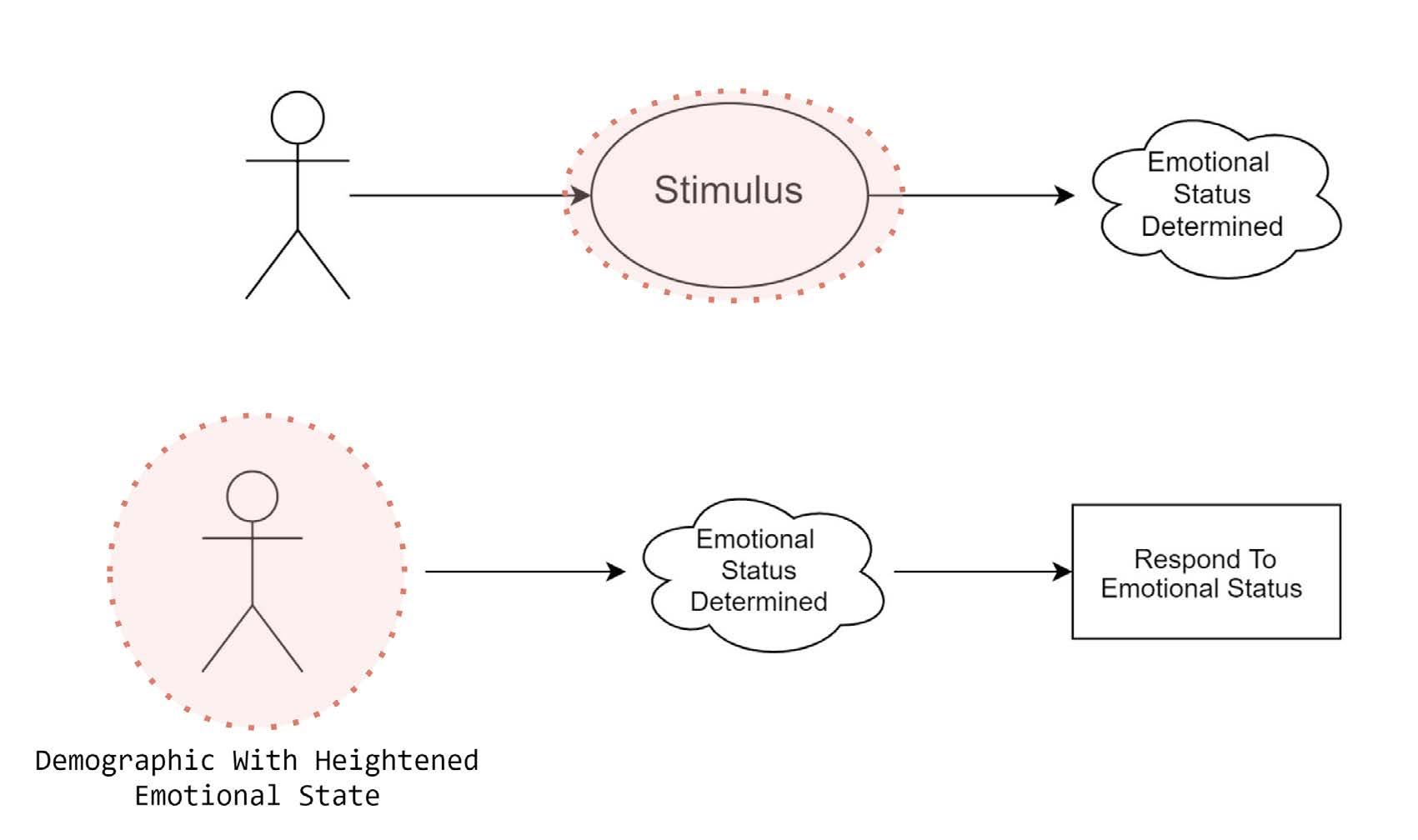
4 minute read
4.1 Design Approach
Emotions are a rather vast and unwieldy lot. Adults can differentiate between a minimum of 50 to 100 different emotional states (Fehr & Russell, 1984 via Karasawa 1995). In order to realistically explore how to deal with such a behemoth topic, it is important to narrow the prototype exploration to the emotions most relevant to a target end user audience. Emotional research studies are generally conducted in response to a stimulus. Environmental psychologists Mehrabian and Russell devised the S-O-R (stimulus - organism - response) paradigm to “explain the relationship among stimuli, environments, responses, and behavioral intention in the context of marketing and consumer behavior research” (Yoon & Wise 2014 p. 222). This paradigm is illustrated in Fig 46. Instead of exposing participants to an emotional stimulus and seeking to evaluate or respond to their emotional state, this prototype will instead be geared towards a demographic that is already in an emotionally heightened state. It is common practice in Architecture to tailor a building’s design to it’s target end user. In this way design decision making can be clarified and different outcomes can be weighed according to the needs of the program required. The prototype for this thesis exists within this framework of an Organic User Interface. In this case the target user of Grieving Adults was chosen. This choice was based on the following factors. Firstly, this group is historically and particularly under-served in Western popular culture and therefore digital media. Furthermore, by aiming to serve grieving individuals, the difficult task of incorporating emotions into architecture becomes grounded in its universality. At the time of this writing, a global pandemic has not only caused families around the world to lose loved ones, but has also robbed them of their abilities to gather and process their grief. Some headlines reflecting this new condition are pictures in Fig 45. In their overview of the idea of Organic User Interfaces as architecture, Nabil et al. establish that the malleable nature of these interactive environments necessitates dialing them in to a target user group. According to Nabil, it is important from the perspectives of both the HCI and Architecture disciplines as “both depend on building their design ‘concept’ on defining the users” (Nabil et al., 2017). In an ideal world, an immersive

Advertisement
Fig. 44 Overall System design

Fig. 45 Headlines Regarding Grieving During the Covid 19 Pandemic environment such as the built prototype would serve as a tool for grieving adults that would help them process their loss by being emotionally responsive. The end user’s emotional status is determined as it relates to the content possibilities that exist in the VR space via a graphic user interface. Many papers have reported an increase in emotions recognition accuracy with an increase in physiological sensor modalities. However there is no clear evidence of which physiological sensors are most relevant, and public data sets for emotion recognition are limited and not based on daily-living scenarios (Bota et al., 2019). Because of the current limitations “self-assessment is widely the most commonly applied methodology in affect recognition state-of-the-art research, with self-reporting questionnaires being presented to the user. “ (Bota et al., 2019) This single GUI interface is not intended to assess the end user’s emotional status on a professional level or offer a comprehensive view of the end user’s emotional health in the way that mood tracking mobile applications or wearable devices seek to. Instead, the GUI is a vehicle for a tailored experience, where the relative emotional status will determine which content is shown in the 3D space. There are three mechanisms to ensure that every individual user has a unique experience in the space that is produced just for them. The first is that the database that the VR platform draws from is constantly being updated with new text data. The second is that the emotional

Fig. 46 Research framework based on the S-O-R model (Yoon & Wise 2016)
readings of each user will always be unique. Lastly, the positioning of the text content within the VR space is generativity programmed so that the location of the text entries in space changes every time the game is initialized. This spatial experience of text is constantly reshuffling and never presents the same order of data twice. In this way, the content of the text and the form of the text are always evolving. The prototype was built using the Unity 3D Game Engine and a Vive Virtual Reality headset and controllers. The data-base was compiled manually from several literature sources and blogs, see Appendix X . Though it was not built for this study, the intent is that the data-base would also host user contributions via a separate stand alone website, pictured in Fig 43.

Fig. 47 Exposing individuals to a stimulus vs designing for individuals with a heigtened emotional state










